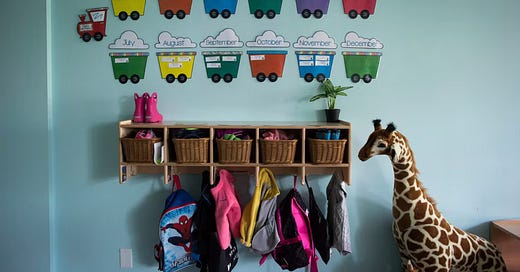Why child care is not a policy priority
Access to affordable child care is increasingly out of reach, leaving many American families and their children with limited options to turn to.
By Maeve McGuire
The reality faced by parents and childcare providers in the United States is stark: early care and education services have become increasingly unaffordable to the average American family. Parents spend anywhere from 11 to 35% percent of their annual income on care for a single child. According to the U.S. Labor Department, daycare and preschool typically run families more than $10,000 a year on average. With a drop-off in federal aid in September 2023, more than 70,000 childcare programs have been projected to close, resulting in an estimated unenrollment of 3.2 million children from daycare programs.
These projections underscore the critical role the American Rescue (ARP) Child Care Stabilization program has been in supporting American families and providers. First announced on April 15, 2021, the historic $24 billion investment in childcare programs impacted as many as 9.6 million children, keeping programs open and families working. Assistance was provided to more than 8 out of 10 licensed childcare centers across the country, with an estimated award of $140,000. In most states, 98% of childcare providers in counties with a persistent poverty rate received funding.
Given the positive impact of this program, questions arise as to why it was not renewed by Congress on September 30, 2023. It wasn’t a matter of public support; 93% of voters believe it’s important for working parents to be able to find and afford quality childcare. However, the Biden administration signaled that it wouldn’t prioritize the program in a funding fight with Republicans because of hyper-partisan Congressional gridlock. With how polarized U.S. politics is, it is more advantageous to shut down the government than achieve legislative consensus. This has forced the administration to carefully select a few policy objectives to fight for. The Stabilization program did not make this cut.
Despite Republicans supporting the view that childcare needs to be more affordable, hyper-partisanship prevents collaborative legislation. This is exemplified by the floundering of Democrat Sen. Murray’s childcare legislation initially proposed in mid-September 2023. Murray, along with a group of Democratic lawmakers, proposed $16 billion in stand-alone funding for childcare over five years. The bill has not been able to move through the chambers of Congress, as Republicans refuse to collaborate and are instead caught in a ‘House Speaker limbo’.
There needs to be a revamp of childcare legislation post-ARP. The White House does not have to watch as critical funding slips away. Instead, they can promote long-term solutions backed by bipartisan coalitions, distribute categorical grants to states that support childcare, and create executive offices dedicated to a national vision of childcare services.
Feasible Long-Term Solutions
ARP funding had limitations: it was a temporary solution not designed to close the gaps in the childcare supply. Long-term solutions require bipartisan efforts and deliberate policy framing to solve the childcare crisis.
Democrats can successfully push through legislation within a hyper-partisan context if they have support from Republican-leaning organizations. One such organization is the U.S. Chamber of Commerce, which supported the idea of a package of tax incentives that can encourage employers to fill the gap. Childcare advocates endorse this idea, and it will prevent severe loss of programs. Combined with “transition-away” policies that have bipartisan support, like childcare subsidies, tax incentives are durable and allow Democrats to garner Republican support without wading through the political theater of Congress. Democrats must frame their policies around the endorsement of a wide array of organizations to weather future political storms.
State Burden-Sharing
Categorical grants to states can also create more durable, long-term solutions and avoid federal infighting. In response to the cut in ARP funding, lawmakers in states including Minnesota, Michigan, New York, and Vermont have injected funding into early childhood initiatives to offset the childcare cost burden.
ARP’s policy framework is already publicized, and states can use this as a stepping-stone in designing state-specific programming. Through categorical grants, or federal funding tied to hitting benchmarks within specific programming, the Biden administration can encourage the development of a robust state framework for supporting childcare.
Re-Centering Childcare in the Administration
Finally, the White House should not abandon childcare from its policy objectives; while it will be difficult to shepherd legislation within Congress, it can control the creation of offices in the executive branch dedicated to finding childcare solutions.
This includes strategies like the creation of a White House Office for Child Services at the federal level and subsequent state offices to coordinate communications. The office can create a comprehensive vision of how to support childcare in the U.S., as well as serve as a research center for better state-specific policy solutions in support of the categorical grants.
Hyper-partisan infighting has affected Americans who desperately need funding solutions for childcare. The White House can override squabbling through a clear-cut vision that engages various stakeholders. The Biden administration can coalition-build, design categorical grants, and create executive offices in support of American families and providers. America needs to achieve these goals for the sake of the millions reliant on childcare.
Maeve is a current MPP candidate at McGill University’s Max Bell School of Public Policy. Joining the school with a background in education, she has also previously completed her BA at McGill in Political Science and History. She is particularly passionate about comparative politics and competition policy.






Thought you’d be interested in this one too https://americaninequality.substack.com/p/childcare-and-inequality